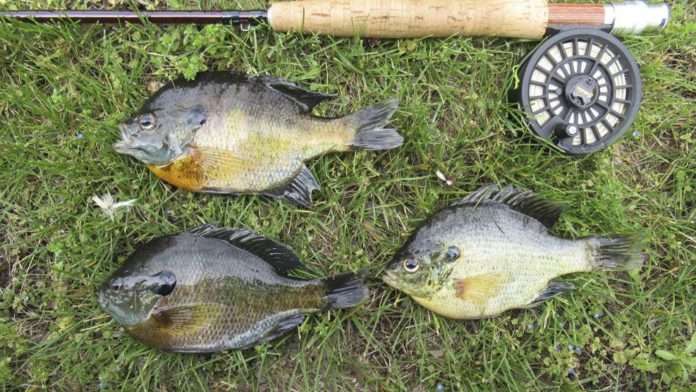One of my favorite outdoor pastimes is fly fishing for bluegills. It’s quite a thrill when a feisty bluegill hits a fly and the battle ensues.
Although I used to fly fish quite frequently, the past few years other activities have interfered. However, this spring I vowed to make fishing a priority. So on Memorial Day weekend, I took some time off from what was turning out to be a very frustrating turkey season to relax and do some fishing.
Fly rod in hand, I had to walk all the way around to the backside of the lake before I spotted a school or pre-spawn bluegills holding near the bank. My first few casts got their interest, and soon my first bluegill of the season was in the bucket.
The fly on the end of my lightweight tippet was a White Wulff. This versatile dry fly is numero uno when it comes to tricking spring sunfish. The White Wulff looks like a big moth or other buggy tidbit to a hungry fish.
I also believe the White Wulff imitates cotton which falls from cottonwood trees in early summer and accumulates on the water. When the cotton starts flying, it’s time to break out the White Wulff.
In short order, it tricked another willing participant, then hooked a third who spit the hook and flopped back down the bank and into the water before I could nab it. Thankfully, the escapee was the smallest fish of the day.
The White Wulff had worn out its welcome, so it was time to tie on something different. After a couple switches with no takers, I tied on the White Wulff’s dry fly cousin, the Royal Wulff.
The Royal Wulff is a variation of fly fishing’s most iconic fly, the Royal Coachman. However, its hair wings and bushy body make the dry fly Wulff version more buoyant than the Coachman, allowing it to float effortlessly atop the water.
The Royal Wulff is my very close second choice when it comes to dry fly fishing for bluegills and, as usual, it didn’t disappoint. It got hits almost immediately and one serious bite that came loose at the last minute.
Finally, the Royal Wulff landed the third fish of the day. With enough nice-sized bluegills to make a meal for my wife and me, I reeled in my floating line and called it a day.
A couple weeks later, I took my fly rod out for another spin. Bluegills were again the target species. Although dry flies got some hits, they didn’t get any commits. It was time to rethink my strategy.
I decided to try a deer hair fly tied by a young fly tier for me using some white tail hair from a doe I harvested last fall with my crossbow. The deer hair was somewhat buoyant, but not enough to float the fly atop the water. Instead, it ran just beneath the surface.
That’s what the bluegills were looking for, though. On the first or second cast, I landed a fish with this special fly. Sometimes dries work best if presented slightly submerged like a wet fly.
However, the bluegills remained extremely finicky, repeatedly refusing other dry fly offerings. With my allotted fishing time quickly coming to a close, I decided to depart from dry flies entirely and tied on a Copper John.
A Copper John is a weighted nymph fly designed to run subsurface. It immediately drew a strike.
While dries are nice, sometimes you have to listen to what the fish are telling you and adjust your game plan accordingly. Fly fishing, just like any type of angling, is dependent on current conditions which can change daily.
On another outing in late-June, dries were again back in business. This time, I used White and Ausable Wulffs to catch bluegills and an unknown, black, buggy-looking dry fly I found in the bottom of my tackle box to trick a feisty green sunfish.
It’s extremely satisfying to watch a fish inhale a fly floating atop the water. Dries may not catch the most fish every day, but they’re always a lot of fun.
I plan to get out a few more times this summer in the hopes of enticing a few more fish to rise to the occasion.
Jarrod Spilger writes an outdoors column for the Independent.
Credit: Source link































